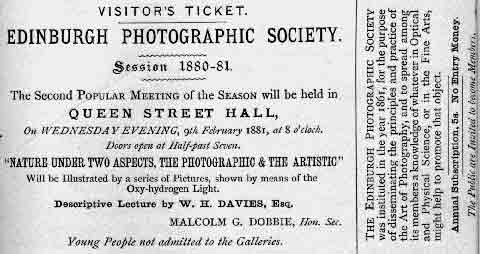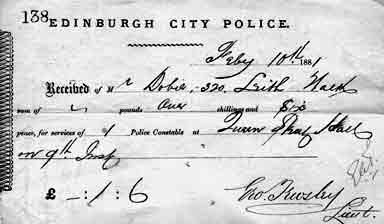Popular Meeting Comments: Intro 1860s 1870s 1880s 1890s 1900sPopular Meeting Lists 1860s 1870s 1880s 1890s 1900sEPS Popular Meetings Introduction Early Years Popular meetings were originally held by the Photographic Society of Scotland. EPS carried on this tradition from 1861 onwards. These meetings were held at on Saturday evenings, at 117 George Street for some years, but moved in 1867 to Queen Street Hall, so as to accommodate the large audience more comfortably. A few meetings may be missing from the list of Popular Meetings. The EPS Minute Books for the years 1861 to 1865 cannot be found, and the meetings may not all have been reported in the Photographic Journals. One visitor to William Neilson’s meeting “Trossachs and Neighbourhood” in 1866 seems to have been particularly impressed. He wrote: “The meeting was very numerously attended. A bond of Brotherhood, so to speak, is engendered. Experiences are given by men of outstanding ability whose sage counsel and thorough practical knowledge are of the utmost service to those who, it may be, are only on the threshold, and with timorous steps feeling their way to attain to some degree of perfection in what they have put their hands to - men to whom, because of their skill, we make profound obeisance, and cherish the memory of others who have been removed from this sublunary sphere giving us all an encouragement to emulate them. Such men as I have indicated have been, and are now, on the roll of membership of the Edinburgh Photographic Society.” Later Years Up to five Popular Meetings were held each year, during the winter season. They were open to Members of Edinburgh Photographic Society and also to members of the Public. Meetings continued until early 20th century, when they were discontinued as a result of competition from cinematography. Meetings were typically travelogues, illustrated with Magic Lantern Slides. By the early 1880s, one meeting per year was devoted to lantern slides by members of EPS, and music and singing was introduced into these meetings - a feature seldom seen at EPS recently (except for the President’s Evening in 1990 when the President, Brian Covell sang “I am the Captain of the EPS”). In the 1880s, the Western Choral Society were regular contributors to the EPS Popular Meetings. A report on the 1887 Meeting read: “During the evening, a select musical party, under the superintendence of Mr William Dougall, greatly added to the enjoyable character of the evening. Miss Hamilton, Mr and Mrs Sinclair and Mr Wright were the vocalists, Miss Shepherd being the accompanist; while ex-Bailie Powrie, of Leith, played in excellent style a selection of Scotch Airs upon the violin. Several encores were called for and all the arrangements went smoothly.” At this time, 1400 free tickets were being issued for each Popular Meeting. Typically 700 people attended, and sometimes as many as 1,000. Visitor Ticket for EPS Popular Meeting - 1881
© Reproduced by courtesy of Edinburgh Photographic Society The
ticket above is one of a set of three distributed to every EPS
Member. EPS Members were entitled to attend Popular Meetings
without charge, but the rules varied from year to year on whether
or not they could also take a guest each, free of charge. One of the expenses, recorded in the EPS Cash Books for some of the Popular Meeting in the 1880s, was the charge of about for the Police Constable on duty. This charge varied between 1/1d and 1/10d per meeting. Receipt for 1s6d for the Police Constable on Duty
© Reproduced by courtesy of Edinburgh Photographic Society Problems at Popular Meetings On occasions there were problems. At the March 1877 meeting: “There was a large and attentive audience, and but for an unfortunate leakage in one of the gas bags which prevented the whole of the pictures being shown, it would have been very successful.” On another occasion, EPS Council considered how to respond to a problem at a recent Popular Meeting. The Council’s report read: “Much annoyance was given by a number of young people during the evening, by shouting, spitting and throwing peas from the gallery. It was resolved that no boys or girls will be admitted unless in the charge of someone who will be responsible for their good conduct during the evening.” Andre Pringle's Travels Popular Meetings gave the audience the opportunity to see other parts of the world. Andre Pringle was a popular speaker. His Scots style can be seen from this extract of his lecture “A Jaunt in Spain”, given to EPS in 1887 “Ye’ll maybe hae mind that twa-three years syne I wrote ye a letter in the auld Scots tongue aboot a jaunt I was takin’ in Italy, the land o’ bawbees an’ beggars; an’ the nicht I’m gaun tae try to gie ye a bit glint intae Spain, the land o’ bulls an’ biggins an maybe o’ a geed wheen blethers. Aye! There’s a gey lot o’ bletherin’ aboot the land o’ Spain” Cinematograph By the late 1890s, some of the evenings included Living Pictures by means of the Cinematograph. It was the arrival of the Cinematograph that led to the demise in of EPS’s Popular Meetings with their lantern slides in 1900.
|
Popular Meeting Comments: Intro 1860s 1870s 1880s 1890s 1900sPopular Meeting Lists 1860s 1870s 1880s 1890s 1900s |

